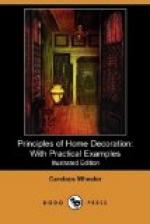The very sufficient knowledge which has gone to the making of this superb room has kept the draperies unbroken by design or device, giving colour only and leaving to the carved walls the privilege of ornament.
It will be seen that there are but two noticeable colour-tones in the room—brown with infinite variations, and red in rugs and draperies.
There is no real affinity between these two tints, but they are here so well balanced in mass, that the two form a complete harmony, like the brown waves of a landscape at evening tipped with the fire of a sunset sky.
Much is to be learned from a room like this, in the lesson of unity and concentration of effect. The strongest, and in fact the only, mass of vital colour is in the carpet, which is allowed to play upwards, as it were, into draperies, and furniture, and frieze, none of which show the same depth and intensity. To the concentration of light in the one great window we must give the credit of the Rembrandt-like effect of the whole interior. If the walls were less rich, this single flood of light would be a defect, because it would be difficult to treat a plain surface with colour alone, which should be equally good in strong light and deep shadow.
[Illustration: DINING-ROOM IN NEW YORK HOME SHOWING CARVED WAINSCOTTING AND PAINTED FRIEZE]
Then, again, the amount of living and brilliant colour is exactly proportioned to that of sombre brown, the red holding its value by strength, as against the greatly preponderating mass of dark. On the whole this may be called a “picture-room,” and yet it is distinctly liveable, lending itself not only to hospitality and ceremonious function but also to real domesticity. It is true that there is a certain obligation in its style of beauty which calls for fine manners and fine behaviour, possibly even, behaviour in kind; for it is in the nature of all fine and exceptional things to demand a corresponding fineness from those who enjoy them.




